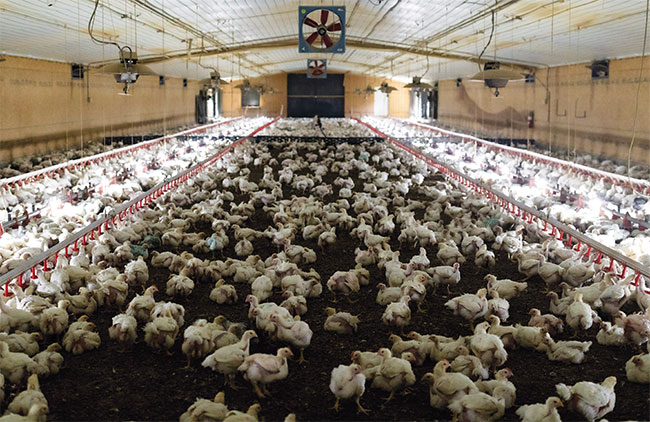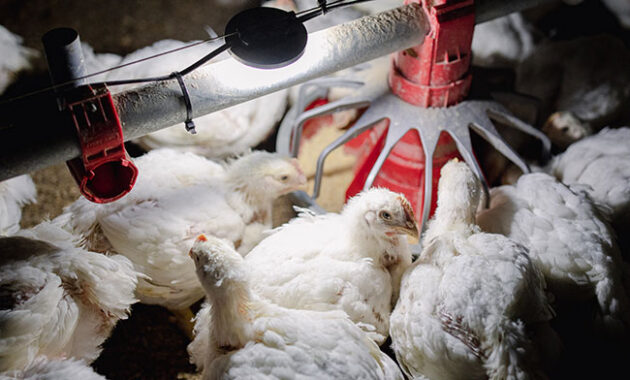
Gradient Lighting: The bright side of darkness
By Melanie Epp
Features New TechnologyInspired by nature, gradient lighting is transformative for broiler welfare. Here's a primer on this technology and what the research shows.
 Researchers found gradient lighting offers broilers choice, promoting calm, varied activities, and improving health in commercial barns.
PHOTOS: Once by Signify
Researchers found gradient lighting offers broilers choice, promoting calm, varied activities, and improving health in commercial barns.
PHOTOS: Once by Signify It’s commonly known that intensity, wavelength and duration of lighting influence broiler activity, feed and water intake, and overall productivity. It’s also well known that light intensity impacts animal welfare and mortality. However, there’s little research that supports current lighting recommendations and, until recently, few studies have looked at how lighting impacts broiler welfare.
A recent study, led by Seong Wook Kang, director of the poultry experiment station at the University of Arkansas, examined lighting preferences in broilers. The commercial-scale study, which was conducted at Tyson Foods’ Broiler Welfare Research Farm in Springdale, Ark., revealed that broilers do have lighting preferences, and giving them choice offers several benefits, including improved feed conversion ratio, reduced fear response and fewer welfare issues. Their findings could be a game changer for broiler welfare on a global scale.
Inspiration from nature
While the vast majority of commercial broiler barns provide uniform lighting conditions, in nature, Red Jungle Fowl live at the edge of and in rainforests where light filters through the canopy unevenly. Drawing inspiration from nature, Kang wanted to know if non-uniform artificial light could be used as a tool to promote broiler welfare and performance.
In 2016, he sought to answer this question through a series of pen trials. Intrigued by the results, Tyson Foods offered up its Broiler Welfare Research Farm to test the effects of gradient lighting in commercial-scale barns. Karen Christensen, Senior Director of Animal Welfare at Tyson, worked closely with Kang on the project.
Broilers are diurnal in nature, which means they eat when the lights come on and rest when the lights are off. In most poultry barns, lighting programs offer 16 hours of light and eight hours of darkness. When the lights came on, the birds would immediately move to the feeders.
In his initial experiments, in order to stimulate eating, Kang installed lighting directly over the feeders. He noticed the birds would move off to dimmer areas for active rest once they were satisfied and wanted to know if he could manipulate lighting further for their benefit.
Trial details
In the commercial-scale study, one-day-old broilers were housed in four commercial broiler houses of 20,000+ birds. Houses were divided into four sections, and each section held 4,800 chicks. A total of four lighting programs began on day seven with 5 lux, 20 lux, natural light (480 lux), and variable light (2–5/40 lux) using LED lights in a photoperiod of 16 hours of light to eight hours of darkness. The broilers were given the choice between the well-illuminated area with feed and water, and shaded areas for active rest. Kang then evaluated the flocks, measuring parameters such as behaviour, mortality, leg health and performance. He also measured brain welfare indicator genes.
In his first observations, Kang noted the birds fought a lot more in the brightly-lit houses. Overall performance fell as well. In the variable-light house, where the flock was given a choice, Kang observed more uniformity. The birds also appeared calmer. Kang also noted the number of dustbathing holes was significantly higher than those found in natural-light houses and 5-lux and 20-lux houses.
Initially, Kang said he wanted to conduct the study to address lameness issues. He thought that increased activity during the early stages of development could improve leg health in the long-term. He was right. The number of leg problem-induced culled birds dropped by 30 per cent in the houses with variable lighting.
“Before, the house was not exciting enough,” said Kang. “Conditions were too uniform. Providing different lighting conditions lets them choose where they want to go – bright or dark areas.”
But it wasn’t just lameness that saw improvement. In fact, daily physical activities, footpad condition, fear response to novel objects, body weight and feed conversion ratio were all positively impacted by the variable-light intensity lighting program. Additionally, lighting costs dropped 70 per cent in the variably-lit houses.
First-hand observations
Tyson Foods, according to Karen Christensen, was eager to participate in the study with Kang. Recommendations around lighting programs were varying and often conflicting, she said.
“That was really concerning to us because we didn’t care what the light intensity was, but we absolutely wanted to make sure it’s right for the bird,” Christensen said. “There just didn’t seem to be a lot of great research as to where some of those numbers came from.”
According to Christensen’s observations, there was a palpable difference in the behaviour of the birds under the different lighting programs. The birds in the variably-lit houses were visibly calmer, she said.
“The birds were quiet,” she said. “But the other interesting part is that they were not just sitting and they’re not just resting. They’re actively eating around the feeders. They’re playing in the transition area between the water lines where it’s still fairly bright. And then we see them moving to the dimmer areas where they are resting and feeling safe.”
But it wasn’t just the stillness and calm, or the movement that surprised her. There were also obvious holes where birds had been dustbathing.
“We really feel that’s a comfort behaviour,” she said. “That is only going to happen at that level when they’re feeling really safe and secure.”
Not only did the researchers see better leg health, but they also noted improvements in feed efficiency, which is counterintuitive given the increased movement observed.
“We’ve seen those metabolic changes that favour the feed line lights, so it really kind of puts the whole picture together,” she said.

Moving lights from the ceiling to feed lines creates a gradient, where it’s brighter near feed pans but tapers to lower intensity lighting between lines.
Variable lighting made simple
While there are many suppliers of lighting options, Tyson opted to go with Optient lighting, developed by ONCE by Signify. Optient is a modular LED lighting solution that uses a patented twist-and-hook system for simple installation in any poultry house. Christensen said the lighting solution is robust.
Tyson put it through ammonia testing to ensure it could last at that height above the litter, and they are pleased with the result. In fact, Tyson believes so much in the benefits of gradient lighting that they made the decision to transition 3,100 of their broiler houses. While it’s a huge project, their customer partners believe in as well and support the transition.
“Optient is really changing the game for the boiler industry,” said Gabrielle House, Poultry Scientist at Signify. “It’s a simple solution that can promote that freedom of choice and optimal performance in commercial boiler houses.”
Taken together, the variable-light intensity lighting program offers several benefits to broiler producers. Research shows that the lighting system promotes volunteer natural behaviours and physical activity, which may improve footpad condition and leg health of birds.
Performance data including the increased daily weight gain and the lowered feed conversion ratio, as well as the results of brain welfare indicator gene expression showed the beneficial effect of the variable-light intensity lighting program on the performance and welfare of commercial broilers.
Optient lighting is now available in Europe, North America and Latin America.
Key facts and figures about gradient lighting
- Research Breakthrough: Recent studies led by Seong Wook Kang at the University of Arkansas unveiled groundbreaking insights into broiler welfare by exploring lighting preferences.
- Commercial-Scale Study: Conducted at Tyson Foods’ Broiler Welfare Research Farm, the study demonstrated that broilers exhibit lighting preferences. Providing them with choices resulted in improved feed conversion ratio, reduced fear response, and fewer welfare issues.
- Inspiration from Nature: Kang drew inspiration from the uneven lighting conditions in nature, particularly the Red Jungle Fowl living in rainforests. Mimicking this non-uniform light in barns proved beneficial for broilers.
- Trial Details: Commercial broiler houses with gradient lighting options were tested, revealing that broilers in variable-light conditions exhibited calmer behavior, reduced fighting, and improved overall performance.
- Positive Impact: Broilers given the choice between well-illuminated areas and shaded spots showed better leg health, reduced fear responses, increased dustbathing holes, and improved feed efficiency.
- Lighting Programs: The study compared different lighting programs, including 5 lux, 20 lux, natural light (480 lux), and variable light (2–5/40 lux). Variable lighting not only enhanced welfare but also reduced lighting costs by 70%.
- Industry Adoption: Tyson Foods embraced Optient lighting, developed by ONCE by Signify, for its modular LED solution. The company is transitioning 3,100 broiler houses to this innovative lighting system.
- Global Availability: Optient lighting is now available in Europe, North America, and Latin America, providing broiler producers worldwide with a simple solution to enhance bird welfare and optimize performance.
Print this page